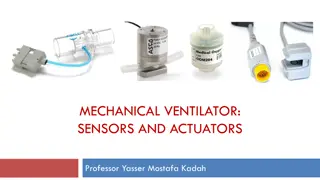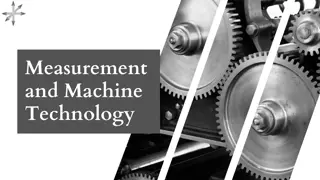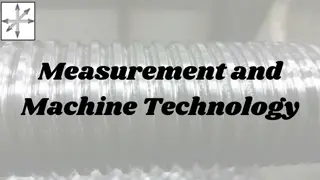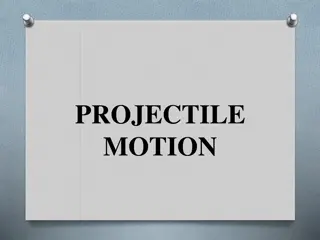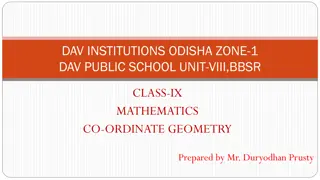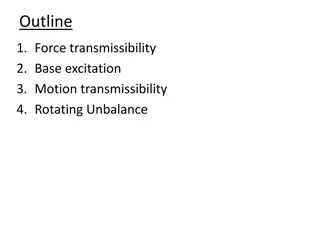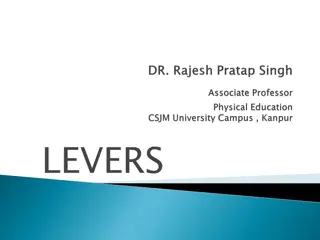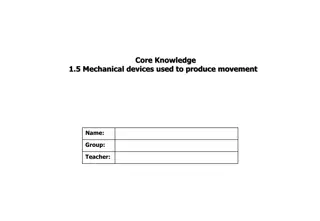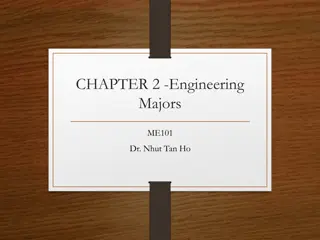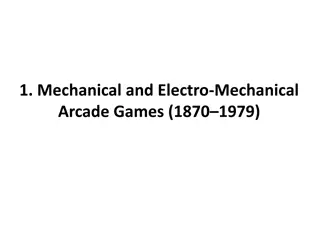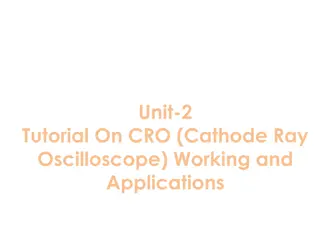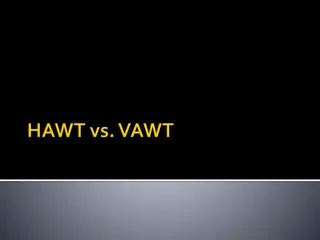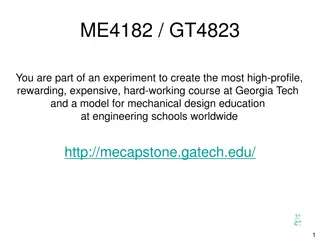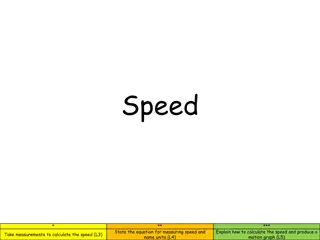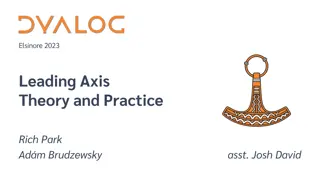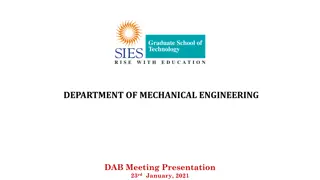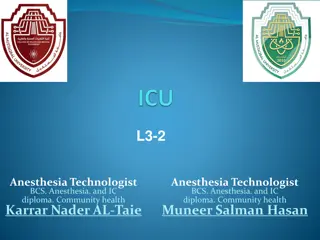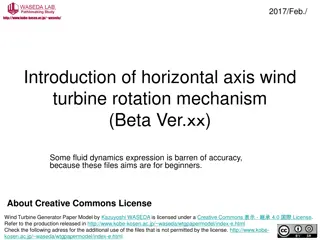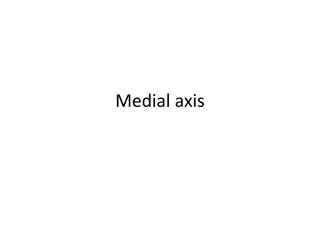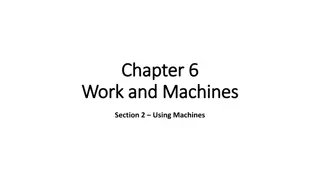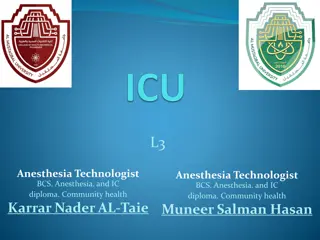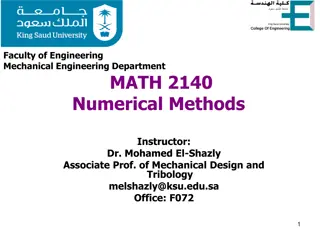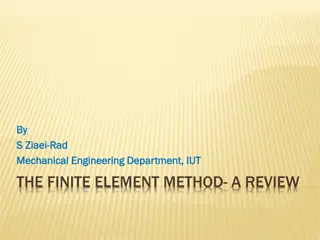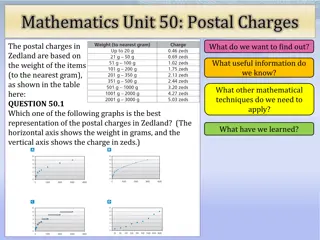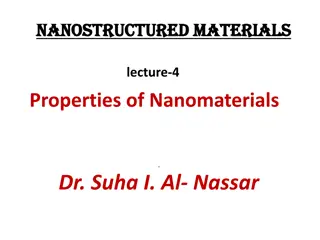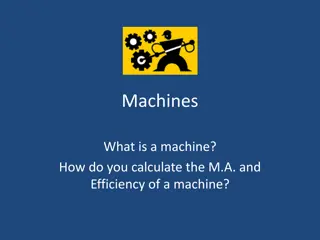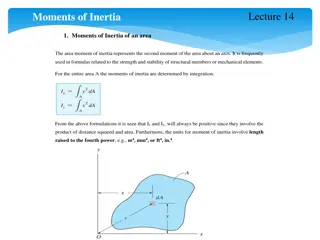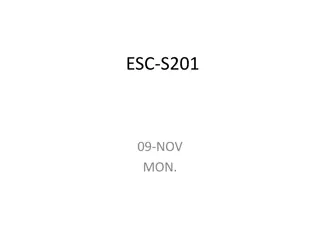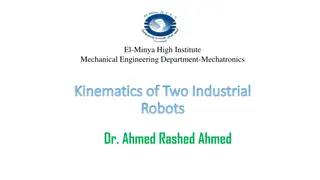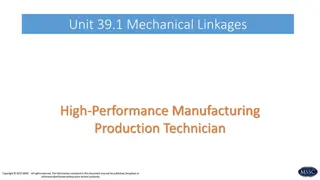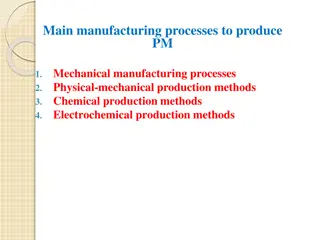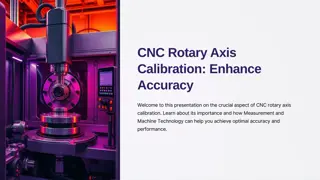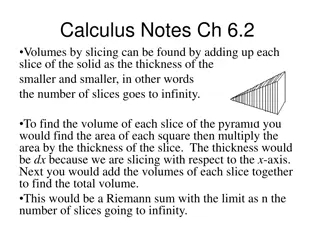Mechanical Ventilator Sensors and Actuators
Explore the essential components of mechanical ventilators, including sensors like pressure and flow sensors, actuators, and oxygen sensors. Learn about the functions and characteristics of these sensors and how they contribute to the operation of mechanical ventilators designed to assist patients w
6 views • 20 slides
Precision Perfected: Rotary Axis CNC Calibration
Achieve unparalleled accuracy with our rotary axis CNC calibration services. Our expert technicians ensure precise alignment, enhancing performance and maximizing productivity for your CNC machining operations.\nCall: 1-313-5305083\nEmail: info@measurementandmachine.com\nWebsite: \/\/measurementand
4 views • 9 slides
Precision Perfection: Rotary Axis CNC Calibration Unveiled
Discover the art of Rotary Axis CNC Calibration, unlocking unparalleled precision in machining. Explore advanced techniques and expert insights at Measurement and Machine for superior manufacturing performance.\nMore information:\nCall us: Phone: 1-313-5305083\nEmail us: info@measurementandmachine.
3 views • 7 slides
Projectile Motion: Characteristics, Examples, and Formulas
Projectile motion involves the motion of objects under the influence of gravity, with both vertical and horizontal components. This type of motion is seen in activities such as throwing a ball, kicking a football, or dropping objects. The motion is described by specific formulas, including calculati
2 views • 19 slides
Overview of Farm Power Sources and Utilization in Agriculture
Farm power sources in agriculture include human, animal, mechanical, and renewable energy. Human power is costly but versatile, while animal power is traditional and provides manure. Mechanical power from tractors and engines is efficient. India's farm power sources reflect a mix of traditional and
0 views • 12 slides
Coordinate Geometry in Mathematics
Coordinate geometry, a system developed in 1637 by Descartes and Fermat, allows for locating points in a Cartesian plane using x and y coordinates. This concept involves recalling coordinate axes, plotting points, understanding quadrants, and solving real-life problems. The history, introduction, an
3 views • 27 slides
Force Transmissibility in Mechanical Systems
Force transmissibility in mechanical systems is crucial for analyzing the relationship between applied forces and resulting vibrations. This outline covers key concepts such as base excitation, motion transmissibility, and rotating unbalance, providing insights into how forces are transmitted and am
0 views • 16 slides
Levers: The Key to Mechanical Advantage
Levers are fundamental mechanical devices that enable the execution of work by producing turning motion around an axis. This article explores the different types of levers, their classifications, and their roles in biomechanics. Understanding levers provides insights into how movement is facilitated
8 views • 24 slides
Commercial Wind Energy Basics
This content discusses the fundamental aspects of commercial wind energy, covering topics such as different types of wind turbines, their components, operational principles, and environmental considerations. It explores the distinction between Horizontal-axis wind turbines (HAWT) and Vertical-axis w
0 views • 16 slides
Mechanical Devices for Movement
Delve into the world of mechanical devices used to generate movement, focusing on levers as a critical mechanism for creating mechanical advantage. Learn about the different classes of levers, their applications, and how they enhance efficiency in various tools and equipment. Explore concepts such a
0 views • 8 slides
Introduction to Mechanical Engineering: Exploring Career Opportunities and Roles
This content delves into the world of mechanical engineering, covering topics such as the characteristics of students interested in engineering, the distinction between engineers and scientists, and the functions of engineers in research. It also provides insights into the differences between engine
7 views • 41 slides
Evolution of Arcade Games: From Mechanical to Digital (1870-1977)
Explore the fascinating journey of arcade games from mechanical and electro-mechanical devices in the 19th century to the birth of digital games in the mid-20th century. Witness the transition from coin-operated amusement machines to early digital arcade games and home consoles, shaping the gaming i
0 views • 37 slides
CRO (Cathode Ray Oscilloscope): Working and Applications
In this tutorial on CRO, you will learn about the working principles of a Cathode Ray Oscilloscope (CRO) and its applications in modern electronics. The CRO is crucial for analyzing waveforms by plotting amplitude against the x-axis and y-axis. Explore the components of a CRO and understand how volt
2 views • 48 slides
Comparison of Vertical and Horizontal Axis Wind Turbines
Vertical axis wind turbines (VAWT) include Darrieus, H-Rotor, and Savonius designs, while horizontal axis wind turbines (HAWT) have advantages such as better performance at greater heights and stronger winds. VAWT face challenges like self-starting and commercial success. Both turbine types operate
1 views • 9 slides
ME 4182 & GT 4823: High-profile Mechanical Design Course at Georgia Tech
Spearheading an innovative experiment, ME 4182 & GT 4823 aim to redefine mechanical design education by fostering interdisciplinary collaboration, problem-solving skills, and real-world applications. Students engage in team-based projects to design mechanical solutions, present detailed specificatio
0 views • 36 slides
Speed and Motion: Equations, Calculations, and Graphs
Speed is defined as the distance traveled per unit of time and is measured using the equation Speed = Distance/Time, with units typically in meters per second (m/s). To calculate speed, measure the distance traveled and the time taken. Motion graphs can be used to visualize speed by plotting time on
2 views • 11 slides
Leading Axis Theory and Practice in Array Kingdom 2023
Exploring the concept of Leading Axis Theory and Practice in the Array Kingdom of Elsinore 2023. The discussion covers essential keys like Rank and Dyadic Transpose, Make Functions apply to whole arrays, and Theory Arrays of various ranks. The images provide insights into major cells, leading axes,
0 views • 32 slides
Department of Mechanical Engineering DAB Meeting Presentation Summary
The Department of Mechanical Engineering held a DAB Meeting Presentation on 23rd January, 2021. The meeting agenda included topics like approval of previous minutes of meeting, academic progress of students, online teaching activities, faculty contributions, and more. The minutes of the meeting disc
1 views • 36 slides
Mechanical Injuries: Types, Classification, and General Principles
Mechanical injuries encompass a variety of harms caused to the body, mind, reputation, or property. These injuries can be classified into medical, legal, and medico-legal categories based on factors like intentionality. The types of mechanical injuries range from blunt force trauma to thermal, chemi
0 views • 79 slides
Mechanical Ventilation in Anesthesia Practice
Anesthesia technologists play a crucial role in managing artificial ventilation, including concepts like Invasive Positive Mechanical Ventilation (IPMV), Fraction of Inspired Oxygen (FIO2), Tidal Volume (VT), Peak Flow Rate, Respiratory Rate, Minute Volume (VE), I:E Ratio, and more. They monitor and
0 views • 27 slides
Horizontal Axis Wind Turbines and Fluid Dynamics
Explore the world of horizontal axis wind turbines through an introduction to the rotation mechanism and foundational concepts of fluid dynamics and airfoil theory. Delve into Reynolds Number, lift and drag forces, and the components of wind turbines. Gain insights into the misconceptions surroundin
0 views • 69 slides
The Medial Axis in Geometry
The medial axis in geometry is a fascinating concept related to Voronoi diagrams and maximal empty disks. Explore how the medial axis is constructed, its significance in the study of polygons, and its applications in modeling and algorithms. Learn about associated exercises and different algorithms
0 views • 12 slides
Machines: Making Work Easier and Mechanical Advantage
Machines are devices that simplify work by increasing force, decreasing force, increasing distance, or changing direction. They operate by transferring energy and work from input to output, with mechanical advantage enhancing force ratios. This summary explores the principles of machines, work done,
0 views • 10 slides
Day, Night, and Seasons on Earth
Earth's rotation on its axis causes day and night, with the Sun appearing to rise in the east and set in the west. The movement of stars, Moon, and planets across the sky each night is due to Earth's rotation as shadows change in length throughout the day. Seasons result from Earth's revolution arou
1 views • 20 slides
Mechanical Ventilation in Anesthesia Technology
Mechanical ventilation plays a crucial role in assisting patients with breathing difficulties by delivering oxygen and removing carbon dioxide. It involves two primary types: Negative Pressure Ventilation (NPV) and Positive Pressure Ventilation (PPV). NPV helps patients with conditions like chronic
0 views • 19 slides
Newton's Interpolating Polynomials in Mechanical Engineering
Explore Newton's interpolating polynomials in the context of Mechanical Engineering, specifically focusing on numerical methods and interpolation techniques. Dr. Mohamed El-Shazly, an Associate Professor of Mechanical Design and Tribology, guides students through the concepts and applications of New
0 views • 17 slides
The Formation and Goals of the Axis Powers in World War II
The Axis Powers, composed of Italy, Japan, and Germany, were established to challenge the existing European order and expand their influence. Through alliances and shared military ambitions, they aimed to dominate different regions of the world during World War II, with Germany targeting Europe, Ita
0 views • 8 slides
Overview of 2018 Performance Framework Milestones
The 2018 Performance Framework Milestones aim to monitor progress towards set objectives and targets. Financial and output indicators are utilized to establish clear milestones. Notable achievements include projects implemented by the UoM under Priority Axis 1 and advancements in e-services applicat
0 views • 24 slides
An Overview of Finite Element Method in Mechanical Engineering
Finite Element Method (FEM) in mechanical engineering is a powerful numerical technique involving dividing a domain into finite elements, establishing relations between variables, and assembling elements to analyze a system. This method is fundamental for solving one-dimensional problems and approxi
0 views • 63 slides
Analyzing Postal Charges in Zedland Based on Weight
The postal charges in Zedland are calculated based on the weight of items to the nearest gram. The task is to determine the best representation graph for these charges, with weight in grams on the horizontal axis and charges in zeds on the vertical axis. By analyzing the provided graphs and applying
0 views • 10 slides
Wind Power: Historical Development, Turbines, and Statistics
Explore the historical development and statistics of wind power, from the first wind turbine in 1891 to the global capacity growth. Learn about the types of wind turbines - Vertical Axis and Horizontal Axis, their advantages and disadvantages, and various wind turbine models. Discover how wind power
0 views • 28 slides
Mechanical Properties of Nanostructured Materials
Nanostructured materials exhibit unique mechanical properties due to factors like grain boundary structure and dislocation movement. Reduction in grain size can enhance strength and hardness while reducing ductility. Nanomaterials may reach theoretical strength levels, significantly higher than sing
0 views • 23 slides
Machines: Calculating Mechanical Advantage and Efficiency
In the world of machines, understanding what a machine is, how to calculate Mechanical Advantage (M.A.), and Efficiency is crucial. Machines alter force, distance, or direction to make work easier but do not multiply work. By assessing input force, distance, and work alongside output force, distance
0 views • 17 slides
Moments of Inertia in Structural Mechanics
Moments of inertia of an area play a crucial role in determining the strength and stability of structural members and mechanical elements. This includes concepts such as area moment of inertia, parallel-axis theorem, and radius of gyration. The integration process, positive nature, and units of mome
0 views • 5 slides
Area Moment of Inertia and Centroidal Axis in Mechanics
Explore the concept of area moment of inertia and centroidal axis in mechanics through detailed explanations and visual representations. Learn how to determine moment of inertia, locate the centroid, and understand the principles behind mass moment of inertia. Dive into the calculation methods and p
0 views • 14 slides
Robotics and Mechanical Design at Minia University
Explore the world of robotics and mechanical design at Minia University's Production Engineering and Mechanical Design Department. From the Kinematics of Two Industrial Robots to the renowned PUMA 560, immerse yourself in cutting-edge technology and innovative research led by experts like Dr. Ahmed
0 views • 13 slides
Mechanical Linkages in High-Performance Manufacturing
Explore the world of mechanical linkages, including the effects of friction on machine operation, operation of machine linkages, and the roles of cams and turnbuckles. Friction is discussed as a force affecting everyday tasks, while cams and camshafts are highlighted for their role in sewing machine
0 views • 8 slides
Main Manufacturing Processes to Produce PM - Mechanical, Chemical, Electrochemical
The process of producing PM involves various manufacturing processes such as mechanical grinding and milling, physical-mechanical production methods, chemical production methods, and electrochemical production methods. Mechanical processes include grinding and milling using jaw crushers, hammer grin
0 views • 12 slides
CNC Rotary Axis Calibration: Enhance Accuracy
Achieve optimal precision with CNC Rotary Axis Calibration services. Our expert team uses advanced tools to ensure your rotary axes are perfectly aligned and calibrated, improving machining accuracy and performance. Minimize errors, reduce downtime,
1 views • 7 slides
Calculus Notes Ch 6.2
Calculus notes on finding volumes by slicing solids with respect to the x-axis using Riemann sums and area calculations. Learn the method with examples using cylinders and rotating shapes. Understand the formula for solid volumes formed when functions are revolved around the x-axis.
0 views • 9 slides
